I got a phone call from Jeff Mottershed, to the effect that a few days ago he went up to the Phelix trail head to carry in the new stove, but accidentally backed his car off the road, and ended up hitch-hiking back to Vancouver with Devlin. He had a plan to get a ride back up, retrieve the car, grab the stove and carry it up, and he would like it if I came along to carry water and snacks. The stove weighs about 150 pounds stripped down and it seems nobody is rated to carry that much. Carla thought it might be fun, or at least more fun than sitting on our back porch knitting, so we left Vancouver Monday noon in the Jeep. After the obligatory stop at Pemberton Macdonalds and some more driving, Carla and I were at the one-log bridge by 5:30pm. Christian Veenstra arrived with Jeff 7:13pm and by 8 Jeff’s car was back on the road and Christian was driving back to Vancouver.
Next morning at 6am we were on the trail. Jeff didn’t think he would get the stove all the way to the hut, and we started guessing where it might stop. He explained that we were likely to run out of Jeff before we ran out of daylight. Carla and I didn’t have any trouble keeping up with Jeff because we didn’t have this 150 lb albatross to carry. There are some parts of the trail that you might not notice if you were just carrying a normal pack. Jeff stopped from time to time. Eventually we got out the GPS so we could say “only xxx metres to the Hut”. Around lunch time we were getting near the lovely woodpile, and Jeff was getting really used up. Knowing when to stop is a hard thing to learn, and it applies to climbing mountains as well as carrying stoves. We finally ground to a stop within sight of the lake.
The run back to the Jeep was easy, and the drive home mostly uneventful. Carla drove, I slept.
What we learned:
The tirfor is a fantastic machine for moving very heavy stuff. From now on where Jeff goes, the tirfor goes.
“Off Road” vehicle
Let’s see if we can pull over this tree on top of the car
Jeff and the tirfor
The last 6 km of road is not improving and there was no sign of the people who put up the survey markers last year and had a plan to do some logging. The road would need a lot of improving before logging trucks could drive it, and there isn’t very much good logging to be done up there.
The one-log bridge is still usable, but there is another, better one log bridge a short distance away. The new bridge should be improved with a rope handrail and possibly some traction mesh.
Old bridge is pretty used up
VOC should have bought the lighter stove. I don’t know who in the Club is rated to carry the stove the last bit around the lake, but the keeners going up this coming weekend will figure it out.
One of the inconvenient bits on the trail
Things seem to be going mostly well, and we should have heat this winter.

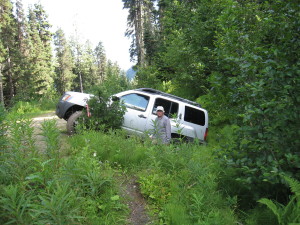
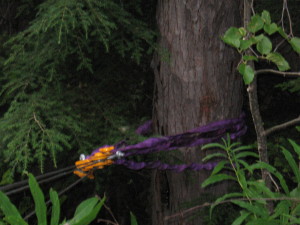
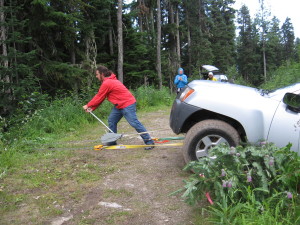
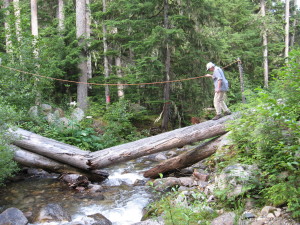
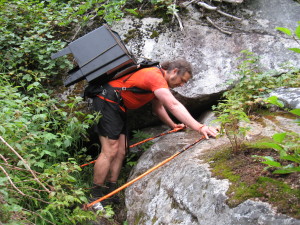
On the truth:
Roland might be rounding up a bit. The stripped-down stove weighed 139 lbs, according to the shipping scale at my work, and the pack was 6 lbs, for a total of a 145 lb albatross.
On the ditching of the vehicle:
I hadn’t been paying attention to the trips schedule, so I was surprised to find the end of the road clogged with vehicles. I initiated a 17-point turn and things were getting tight, so I got Devlin to get out and show me how much room I had. He kept dropping his hands below the hood, and I kept telling to hold them up where I could see. After the fifth time he’d had it with being told and starting flailing his hands around. I tried to wing it without him, felt a sudden drop, hit the brakes but still slid down into the muck in a four-wheel skid.
Devlin said sorry quite a few times without being prompted, and I felt the shame and the guilt as well. We gave up on the stove for that day and walked to Blackwater where the second vehicle we thumbed picked us up. The dude’s name was Travis and he’d apparently, on a number of occasions, rescued a group of lost, wet and frozen VOCers who had taken the wrong fork on the road en route to the hut. He’d let them sleep in his cabin after snowmobiling them out, which is a fairly justifiable use of a snowmobile.
Anyways, after Travis dropped his boat and family off at his cabin he had to take some saws into Pemberton, so he gave us a ride to the Pemberton PetroCan. We were picked up by the first vehicle there. I was wearing an old VOC shirt, and the retired lady in the van asked if I was VOC. I said we both were, and she said that she used to be as well. She reminisced about doing the Salty Dog Rag in the Whistler Cabin, back in the good ol’ days before they stole the Whistler Cabin.
On buying stoves:
Apparently we seem to think that a great big stove that has an 86% efficiency will use less wood than a little, reasonable-to-carry-and-less-expensive stove with a slightly lower efficiency.
I recognize that this next bit is unwelcome education, that what’s done is done and I should just get over that I was too lazy and weak to haul the stove to the hut, that no one cares what I think and that annoying people won’t change their behaviour, but I feel compelled to point some things out. This is how you figure out how much wood a stove will use:
Assume there are yahoos in the hut. This is almost always true. The yahoos will jam as much wood as will fit in the stove when they get to the hut, and they’ll jam it full again again before they go to bed. Then they’ll do it again in the morning. So take the volume of the stove, multiply it by three and that’s how much wood goes per day the hut is occupied. It doesn’t matter if it’s a bad stove or a good stove, if it’s efficient or not efficient, if it’s hardwood or softwood, wet wood or dry wood–that’s how much they use.
Some might argue that there are lots of yahoo-free days in the hut, but that was when there wasn’t a stove. Now we’re getting a great big-yahoo attractant.
If the yahoos put three full loads of dry, seasoned mahogany in a huge stove they’ll succeed at melting the cheese and chocolates in everyone’s pack. If the stove is a few percent higher efficiency they might melt the packs themselves. If they have half-decomposed softwood and a little stove then the hut ends up at more or less the right temperature.
No one likes hauling giant amounts or firewood or oversized stoves, having their cheese melted or lying in a pool of sweat and scratching their itchy junk all night. All these problems are solved with a little stove.
I just realized that “annoying people won’t change their behaviour” could be parsed equally well with “annoying” being a verb or an adjective. Yikes. It’s a verb. Hopefully it’s clear that I mean that by flapping my gums I am annoying the people.
Goods points about the stove size/wood consumption. While we were hauling wood, we had a lot of time to think about that kind of stuff.
The problems you pointed out are valid with people keeping the stove full chooch while they are there. We also thought about the problem of really small groups (2-3) trying to heat up the hut and not succeeding because they don’t have the body heat of a full hut.
Hopefully building the wood storage shed on the other side of Long Lake, and requiring people to carry in the wood they’ll use for the “last mile” will lessen the yahoo detriments.
One option would be to put a few refractive bricks at the bottom of the stove, that way there will be less space to stuff it with wood (and the heat will continue radiating from the bricks, helping perhaps to keep the hut a little drier longer)